|
There are in Banffshire a
number of interesting ruins of castles and ancient forts. The earliest
strongholds were of the simplest kind—the hill or rock fort, the lake
crannog, and the ha' hill. The hill fort was perhaps the earliest of all.
One stands on Conval top. Sometimes the top of a rock on the coast or
elsewhere was partially fortified. Of this, two rocks about a mile to the
east of Tarlair, near Old Haven, are interesting examples and are among the
oldest and rudest specimens of fortifications in the county.
As skill in the art of
building was acquired, such structures were replaced, on the same or more
suitable sites, by others more formidable, like that which hangs in ruined
grandeur on the sea-crags of Findlater. In the two centuries preceding the
death of Alexander III, when the settlement of Churchmen and of Norman and
Saxon nobles was encouraged, architecture worthy of the name was cultivated
with zeal and success, and to this period may belong the Royal fortresses of
Banff and Cullen and the baronial castles of Boyne and Findlater. The styles
of architecture commonly employed were the Norman or Romanesque of the
twelfth, and the Early English or First Pointed of the thirteenth century.
The fifteenth century witnessed the rise of a new kind of stronghold,
commonly known as the Scottish Baronial Tower. These massive towers, rising
floor above floor to a considerable height, and having their one door placed
for safety in the second storey, afforded shelter and protection, if little
else. The castles of Deskford and Inchdrewer belong to this class or are
modifications of it.
The ruins of Findlater
Castle, in the parish of Fordyce, are among the most picturesque in the
county. A miniature Gibraltar in the day of its strength, the old castle
stands on a peninsulated rock by the sea shore and still affords evidence of
its former importance. John Leslie, Bishop of Ross, in his History (1578)
describes it as "a castle so fortified by the nature of its situation as to
seem impregnable," while Gordon of Straloch calls it in 1662 "deserta arx."
A tradition current locally
explains why it ceased to be a family residence. While the nurse of the
infant son of the lord of Findlater was walking on the sea battlement, or
standing at an open window, on a genial summer day, singing and dandling the
child, he, of a sudden, sprang from her arms in his glee, and disappeared in
the gulf below, not, however, without a wild and vain attempt on the part of
the nurse to save him. She, too, rushed headlong into the water and
perished. The baron, overcome with grief, left the castle never to return,
and Findlater became, what Straloch calls it, a deserted stronghold.
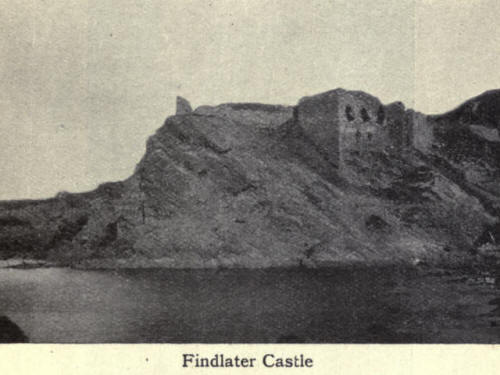
On a rocky peninsula, jutting
into the sea on the west side of the burn of the Boyne, some remains of
buried foundations and a few masses of shapeless masonry mark the site of
the original stronghold of the Craig of Boyne. Of it nothing is now known
beyond what may be gathered from a survey of its ruins. A mile from the
mouth of the stream, occupying the level summit of a precipitous bank
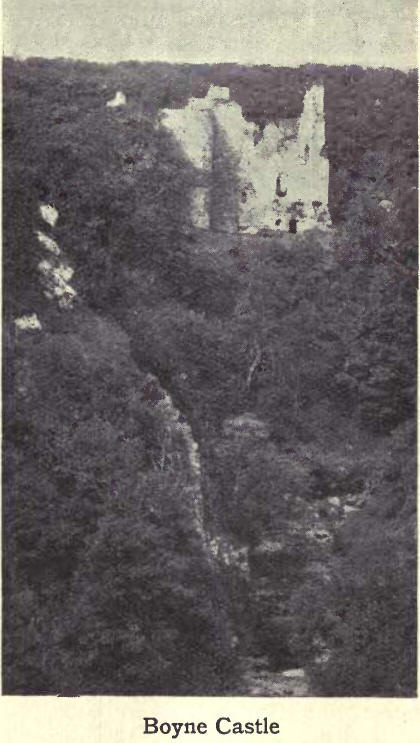
forming the eastern side of a
ravine through which the stream flows, are the picturesque ruins of a more
recent Castle of the Boyne, built probably in the sixteenth or the
seventeenth century, which still suggest to the beholder a strength and
magnificence unequalled by any other stronghold in the district.
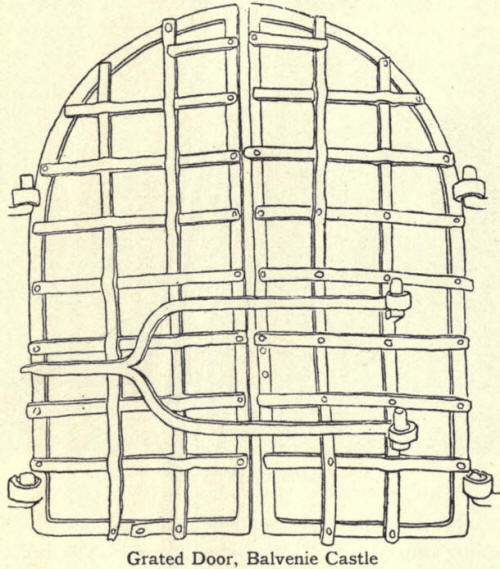
The ruins of the Castle of
Balvenie are close to Duff-town. The castle,of unknown antiquity, formed
part of the extensive domains of the Comyns. On the forfeiture of the Comyns,
it passed to the Douglas family. They suffered forfeiture in 1455; and the
King bestowed the Barony of Balvenie on Sir John Stewart, who was created
Earl of Atholl. The Atholl motto may still be read on this old castle:
"Furth Fortuine & fill thi
Fettris."
Balvenie next fell to the
Gordons, then to the Inneses, and then to the Earls of Fife. The ruin is in
excellent preservation. The four walls, still standing, are of great
strength, and are in some portions three or four feet thick. A
characteristic feature is the grated iron door.
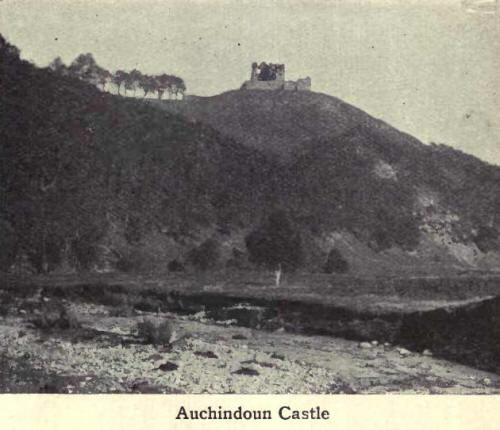
The ruins of the Castle of
Auchindoun occupy a commanding situation on Fiddichside. According to
tradition it was built in the eleventh century when the Danes were
struggling for supremacy in the province of Moray. Since 1535 it has been in
the possession of the Gordon family. In an issue of the Quarterly Review of
1816 Sir Walter Scott has told the legend of the burning of Auchindoun by
"Willie McIntosh." In the ballad it is related how
Licht was the mirk hour
At the day dawin'
For Auchindoun was in flames
Ere the cock crawin'.
At Drumin, near the junction
of the Livet with the Aven, stands the old castle of Drumin, where Argyll
encamped previous to the Battle of Glenlivet and where several of the
neighbouring clans joined his standard. Its founder is believed to have been
Alexander Stewart, Earl of Buchan, "The Wolf of Badenoch." At all events, in
1490 the Castle of Drumin and lands pertaining thereto were disposed by Sir
Walter Stewart, grandson of the "Wolf of Badenoch," to Alexander, third Earl
of Huntly, and the property has ever since remained in the hands of the
Earl's descendants. In later years Drumin became celebrated in the sphere of
music, for it was the residence of William Marshall, described by Burns as
the first composer of strathspeys of the age.
The Castle of Blairfindy, in
Glenlivet, now exhibits only roofless walls. It was a square tower or keep,
three storeys high, and dating from the latter half of the sixteenth
century. An old distich runs:
Glenlivet it has castles three
Drumin, Blairfindy, and Deskee.
A farm now bears the name of
the third, and but for the rhyme, it would hardly be known that a castle had
existed.
Of the Palace of Banff, owned
by Sir George Ogilvy, nothing remains. It was destroyed by General Monro in
his fateful visit to the town in 1640. King Charles in 1641 gave Sir George
ten thousand merks Scots in gold "yet too little to repair his losses," and
in the following year made him Lord Banff.
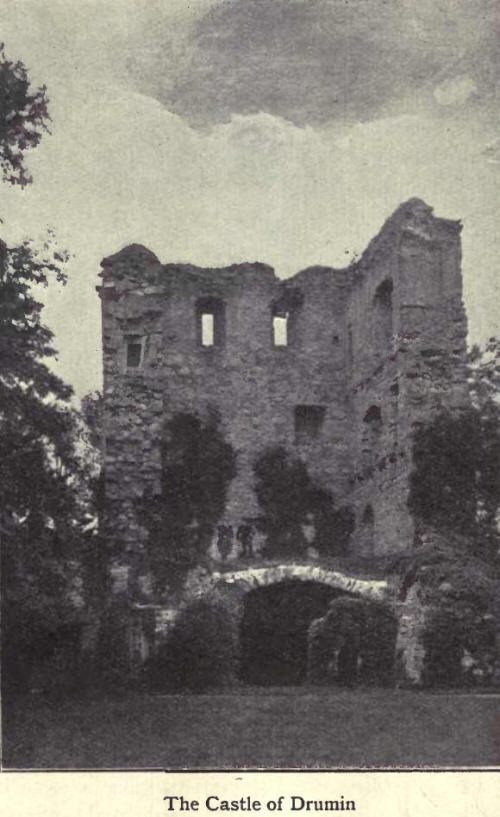
The ancient Royal Castle of
Banff has been somewhat more fortunate, for part of its walls are still to
be seen, almost six and a half feet thick, and portions of its moat or
fosse. It was the last stronghold occupied by English troops north of the
Grampians after the battle of Bannockburn. Among those who have stayed in it
are Edward I, who was on three occasions at least within its walls, and who
held a Court at Banff in 1303; David II with the Queen and his sisters;
Queen Margaret, wife of James III; James IV; Mary of Guise, and Queen Mary.
During part of the seventeenth century it was tenanted by William Sharp,
Sheriff Clerk of Banff, whose son James, the murdered Archbishop, was born
there in 1618. Bought later by the Sharps, it passed in succession to the
Leslies of Kininvie and the Earls of Findlater, and it remained in the
possession of the latter family till 1878. The present modern house of Banff
Castle was built by James, sixth Earl of Findlater and third Earl of
Seafield.
The Baronial Tower or Castle
of Inchdrewer, in the parish of Banff, has been referred to the reign of
James IV. Inchdrewer was destroyed by General Monro, even its iron gate
being sold to a countryman for five merks "whilk an hunddred pounds had not
put up." |

